Scotland's digital strategy: evidence discussion paper
Summary of important links between digital and economic productivity and inclusion, changing the way we live and work in Scotland.
4. Scotland's Digital Performance
- 88% of premises have next generation broadband access
- 92% of premises have 4G coverage.
- 98% of businesses have internet access.
- 87% of businesses have a website.
- 15 universities provide computer science courses.
- 81% of citizens have basic digital literacy.
- 82% of adults use the internet for personal use.
- 86% of adults who used a public service website were satisfied with the overall quality.
- 92% of adults who use the internet take some form of online security measures.
This section tracks progress to becoming a world leading digital nation based on currently available data. This highlights where Scotland performs strongly and where there are opportunities for further development.
Where possible, comparisons have been made with the UK and European nations and where comparisons over time are made, this will generally cover the period over which the data has been collected. The selected comparator countries have been chosen because they have similar economic characteristics to Scotland, in that they are small, open to trade and advanced economies.
4.1 Connectivity
In 2016, the option of subscribing wto a next generation broadband network was available to 88% of residential and business premises in Scotland. As shown in figure 4.1.1, this was up 3 percentage points from the previous year and 47 percentage points from 2011.
Figure 4.1.1: Proportion of premises where next generation broadband access is available. [74]

Source: Ofcom, Connected Nations and Infrastructure Reports
Although next generation access data for comparator countries in unavailable for 2015, Scotland performs well in relation to similar countries. Next generation access within Scotland is slightly lower than the UK figure of 89% but has increased significantly between 2014-15.
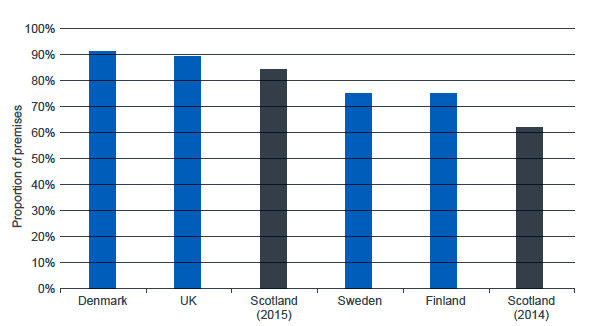 Figure 4.1.2: Next generation broadband access for European Countries and Scotland, 2014 and 2015.
Figure 4.1.2: Next generation broadband access for European Countries and Scotland, 2014 and 2015.
Source: Ofcom, Connected Nations, Broadband coverage in Europe by IHS and VVA.
In addition, access to superfast broadband across Scotland has increased over time, with 83% of premises having access in 2016 ( Figure 4.1.3). Although the difference in coverage between rural areas and the rest of Scotland has decreased over time, a gap of 37 percentage points still remains in 2016.
Average broadband speeds across Scotland in 2016 were 35 Mbits/s ( Figure 4.1.4). Although average broadband speeds have increased within both urban and rural areas, the gap has widened over time and a difference of 24 Mbits/s still remains in 2016.
As well as fixed coverage, people increasingly rely on good quality mobile connectivity. The proportion of Scottish premises in areas with outdoor 4G mobile coverage from at least one national mobile network operator was 92% in May 2016, an increase of 35.6 percentage points from 2014. Additionally, more than half (58.4%) of premises have outdoor coverage from all four 4G networks.
Figure 4.1.3: Proportion of premises where superfast broadband access is available. 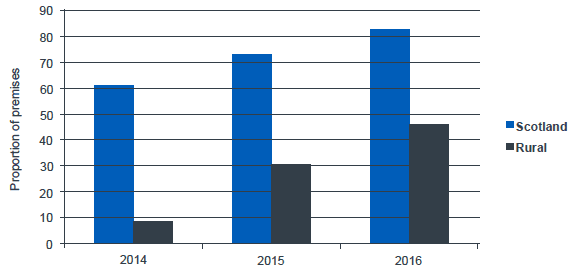 [75]
[75]
Source: Ofcom, Connected Nations and Infrastructure Reports.
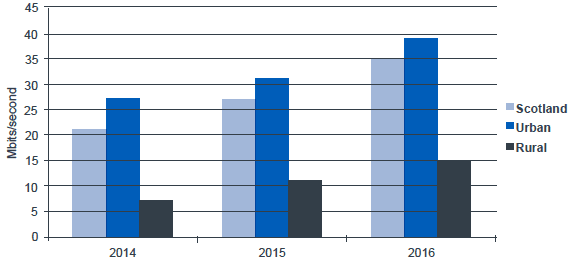 Figure 4.1.4: Average broadband download speeds.
Figure 4.1.4: Average broadband download speeds.
Source: Ofcom Connected Nations and Infrastructure Reports.
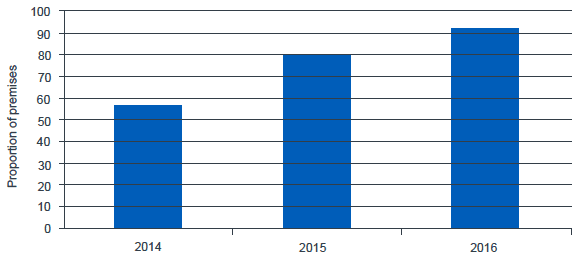 Figure 4.1.5: Proportion of premises with outdoor 4G mobile coverage.
Figure 4.1.5: Proportion of premises with outdoor 4G mobile coverage.
Source: Ofcom Communications Market Reports.
4.2 Skills
Education
There are a range of qualifications which can be undertaken by individuals to support the development of digital skills, including national qualifications, modern apprenticeships and university degrees.
National Qualifications
Enrolment in Scottish Qualification Authority ( SQA) Higher Computing increased by 8.25% between 2011-14, with 71% achieving an A to C grade pass in 2014. [76] , [77] Furthermore, enrolment in Advanced Higher Computing increased by 10.4% between 2011-15. [78]
However, there is a strong gender divide within computing education. Figure 4.2.1 demonstrates that the number of females enrolling in Higher Computing has steadily declined over time. Although the number of male entries has fluctuated, enrolment is consistently above females. In 2015, only 19% of Higher Computing students were female.
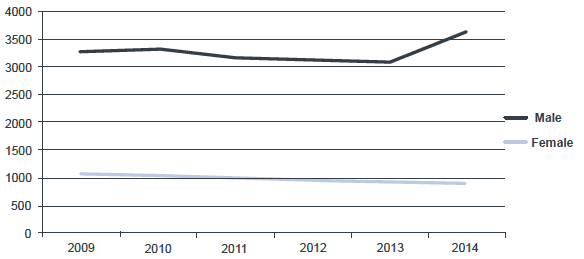 Figure 4.2.1: Number of entries in Higher Computing by gender, 2009-2014.
Figure 4.2.1: Number of entries in Higher Computing by gender, 2009-2014.
Source: SQA Annual Statistical Report, Higher
Modern Apprenticeships
There is growing acknowledgment of alternative routes into a career in digital such as modern apprenticeships, which are being increasingly utilised by larger companies. During 2015-16, there were approximately 950 people enrolled in modern apprenticeships in digital technology-related subjects in Scotland, with an achievement rate of 73%. 85% of those enrolled in digital-related modern apprenticeships were male. [79]
Employers of digital-related posts who do not use modern apprentices tend not to do so because they do not believe they are at the right level for the business or because they prefer recruiting graduates. [80]
University and College Education
Around three quarters enrolled in ICT and computing college courses in 2014-15 were male. Males also accounted for a much higher proportion of credits (85%), indicating they are more likely to select more intensive courses than females. [81]
Higher education remains a key route into a career within the digital technologies sector, with many roles requiring degree qualifications and specific skills and knowledge.
The vast majority of universities in Scotland offer digital technology-related courses. Fifteen Scottish universities currently provide computer science courses at undergraduate level, with the majority offering additional postgraduate qualifications. [82] The number enrolled in computing and ICT-related courses at Scottish universities was 15,111 in 2014/15, an increase of 4% from the previous year. 75% of those enrolled were male. [83]
In-Work Training
Up-skilling the current workforce is an important way of responding to the digital skills gap and keeping pace with new digital developments. The proportion of employers that provide training to develop their employees' digital skills is low, with only 26% of businesses in Scotland reporting that they were taking action to develop employees digital skills and a further 18% planning to do so in the future. [84]
Although internationally comparable data is unavailable for Scotland, the UK as a whole lags behind comparator countries in terms of the provision of training to develop ICT skills of existing staff. Figure 4.2.2 demonstrates that 27% of UK enterprises provided ICT training to their current workforce.
Figure 4.2.2: Percentage of enterprises that provide training to develop/upgrade ICT skills of their staff, 2015.
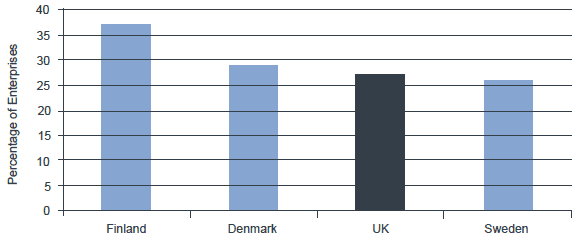
Source: Eurostat.
Basic Digital Skills
According to study conducted by Ipos MORI which examined digital capabilities across the UK, Scotland has one of the highest percentages of adults with basic digital skills. [85] 81% of adults in Scotland reported having basic digital competency. Individuals were classed as having basic digital skills if they reported being competent in all five basic digital skills areas, including: managing information, problem solving, communicating, creating, and transacting.
However, certain demographic groups in Scotland are less confident in carrying out online activities. Among those that have internet access, a lower proportion of adults in social housing were very or fairly confident in their ability to perform a variety of online activities than those in private rented housing. Those aged over 60 and those on incomes between £10,000-£20,000 consistently reported being less confident than average across all activities.
Figure 4.2.3: Percentage of adults with basic digital skills across the UK regions.
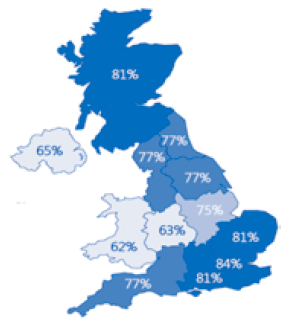
Source: Basic Digital Skills Tech Tracker 2015.
Figure 4.2.4: Confidence in pursuing activities when using the internet by tenure.
| Adults who make personal use of the internet | Owner occupied |
Social rented | Private rented | Other | All |
|---|---|---|---|---|---|
| Send and receive e-mails | 93 | 86 | 95 | * | 92 |
| Use a search engine | 96 | 92 | 99 | * | 96 |
| Shop online | 88 | 77 | 91 | * | 87 |
| Use public services online | 86 | 69 | 89 | * | 84 |
| Identify and delete spam | 83 | 73 | 88 | * | 83 |
| Be able to tell what websites to trust | 80 | 73 | 88 | * | 81 |
| Control privacy settings online | 74 | 74 | 85 | * | 76 |
| Base (minimum) | 1,470 | 390 | 310 | 20 | 2,190 |
Source: Scottish Household Survey 2015
4.3 A Digital Society
In 2015, 81.9% of adults reported using the internet outwith work, an increase of 19.2 percentage points from 2007.
Although Scotland as a whole has high rates of internet use, this is strongly linked to age and household income. In 2015, 96.5% of 16-24 year olds used the internet, compared to 68.7% of 60-74 year olds and under a third of people aged 75 and older. Since 2007, the proportion of people making use of the internet has increased across all age groups. Those aged 60-74 have seen the greatest increase. However, internet use by age is expected to improve over time as young people, who are the primary users, transition into older age groups.
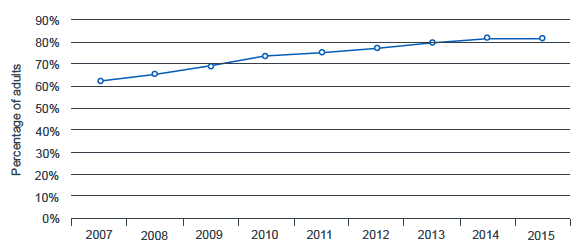 Figure 4.3.1: Percentage of adults using the internet for personal use.
Figure 4.3.1: Percentage of adults using the internet for personal use.
Source: Scottish Household Survey.
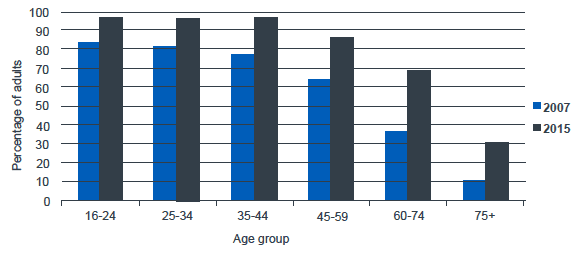 Figure 4.3.2: Percentage of adults using the internet by age.
Figure 4.3.2: Percentage of adults using the internet by age.
Source: Scottish Household Survey.
In addition, there is a positive relationship between internet usage and household income, although a break in the pattern for income bracket £6,001-£10,000 is present. This is because students are overrepresented in the lowest income bracket of below £6,000, and are very likely to have interent access at home. The gap in internet usage between households within the lowest and highest income brackets has decreased from 58% in 2007 to 21% in 2015.
The proportion of households with home internet access is highest in accessible rural areas at 85% ( Figure 4.3.4). Internet take-up within urban and rural areas is broadly similar. However, there are differences between local authourity areas, with 89% of premises in Edinburgh and East Dunbartonshire having home internet access, compared to 73% in Glasgow.
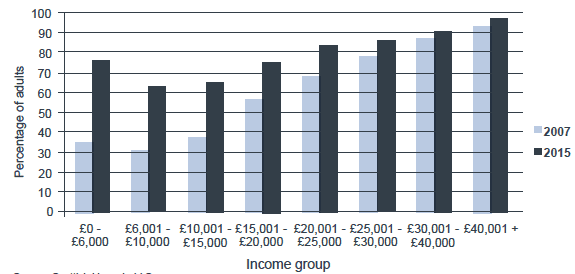 Figure 4.3.3: Percentage of adults using the internet by annual household income.
Figure 4.3.3: Percentage of adults using the internet by annual household income.
Source: Scottish Household Survey.
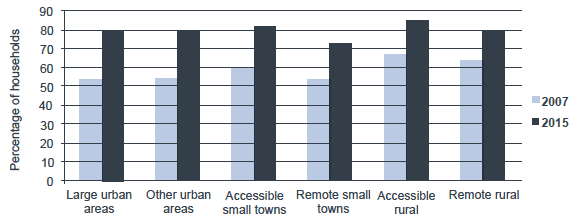 Figure 4.3.4: Households with home internet access by urban/rural classification.
Figure 4.3.4: Households with home internet access by urban/rural classification.
Source: Scottish Household Survey.
4.4 The Digital Economy
The Digital Economy Maturity Index segments businesses in Scotland according to their level of digitalisation. [86] The index is based on four aspects of digital technologies: adoption, usage, benefits, and skills.
The vast majority of Scotland's businesses are classed within the second lowest or middle maturity segments, basic browsers (38%) and tentative techies (30%). Businesses classified within these segments tend to have broadband access and adopt a few digital technologies, such as a website and mobile technologies. However, they tend to lag behind in the adoption of more advanced technologies, such as cloud computing and management software. Such businesses are likely to not to see the full potential of how technologies can benefit the business.
Only 3% of Scottish businesses were classed as digital champions. These businesses are among the most likely to have adopted next generation broadband access, tend to have a digital strategy, and use digital technologies extensively.
Figure 4.4.1: Scotland's Digital Economy Maturity Index, 2014.
| Disconnected Doubters | Basic Browsers | Tentative Techies | Enthusiastic Explorers | Digital Champions | Digital Pioneers | |
|---|---|---|---|---|---|---|
| Proportion | 13% | 38% | 30% | 15% | 3% | 0.2% |
| Number | 14,100 | 40,200 | 31,500 | 16,100 | 3,100 | 250 |
Figure 4.4.2 demonstrates the general characteristics of businesses that were classed within the highest and lowest digital maturity segments. Businesses within the 'disconnected doubters' segment tend to be small, have little growth expectations, and lower annual turnover compared to other segments. Comparatively, businesses classed as 'digital champions' tend to be medium sized, expect to grow, export and have a higher annual turnover.
Figure 4.4.2: Business characteristics of digital maturity segments.
| Characteristic | Disconnected Doubters | Digital Champions |
|---|---|---|
| Size | Small and micro businesses are overrepresented in this segment. | Medium businesses are overrepresented in this maturity segment. |
| Sector | Wholesale/retail, agriculture and construction sectors are overrepresented in this segment | Transport/Communications, Manufacturing and other services are overrepresented in this segment. |
| Age | Are often over 10 years old (84%). | Are ofter between 3-10 years old (48%). |
| Growth Expectations | Expect to stay about the same size in the coming year (62%). | Expect to grow moderately (50%) or expect to grow substatially (22%) in the next 12 months. |
| Turnover | Relative to other segments tend to have an annual turnover of less than £100,000 (37%). | Tend to have an annual turnover of more than £250,000 but below £1million (31%). |
| Export | Tend not to export (5%). | Tend to be exporters. |
| Adoption of digital | Tend to have adopted one technology -either website or mobile technologies. | Tend to have adopted most of the six technologies. |
| * All percentage figures throughout exclude don't knows |  |
 |
Source: Digital Economy Maturity Index 2014.
The vast majority of businesses in Scotland have access to internet connection. Figure 4.4.3 demonstrates that 98% of Scottish businesses have internet access, compared to 95% within the UK and 97% across the EU. In addition, internet access across smaller Scottish businesses is high. 94% of small and medium enterprises reported having access to the internet for work in 2015. [87]
Figure 4.4.3: Proportion of businesses with internet access, 2014. [88]
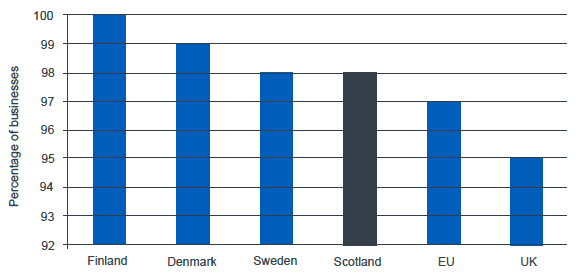
Source: Eurostat, Digital Economy Business Survey.
Figure 4.4.4 demonstrates that although a greater proportion of Scottish businesses have a website than the UK and the EU average, Scotland tends to perform worse on the use of more advanced digital business tools, including Enterprise Resource Planning, Customer Relationship Management and Supply Chain Management.
Figure 4.4.4: Business use of digital tools, 2014. [88]
| Rank | Businesses with a website (%) | Businesses using Enterprise Resource Planning (%) | Businesses using Customer Relationship Management (%) | Businesses using Supply Chain Management (%) | ||||
|---|---|---|---|---|---|---|---|---|
| 1 | Finland | 95 | Sweden | 43 | Denmark | 28 | Denmark | 26 |
| 2 | Denmark | 91 | Denmark | 42 | Norway | 28 | Finland | 21 |
| 3 | Sweden | 89 | Finland | 39 | Sweden | 26 | EU | 17 |
| 4 | Scotland | 87 | EU | 31 | UK | 22 | Sweden | 13 |
| 5 | UK | 80 | UK | 12 | Scotland | 19 | UK | 13 |
| 6 | EU | 74 | Scotland | 6 | EU | 18 | Scotland | 8 |
Source: Eurostat, Digital Economy Business Survey.
In addition, a Lloyds survey of small businesses and charities ranked Scotland with a digital index score of 57, compared to the UK average of 54. [89] 23% of Scottish businesses surveyed reported using digital to trade overseas, in comparison to 21% in the UK. Moreover, 51% actively create social media communications which is 6% higher than the UK average.
Scotland's Digital Sector [90]
The digital sector in Scotland has experienced strong growth in recent years, providing an important source of employment and contributing to wider economic growth. The digital sector definition used consists of the service side of digital, including telecommunications, consulting and programming activities, as well as manufacturing of digital infrastructure and related equipment.
Enterprises
- The number of registered enterprises in Scotland's digital sector was 9,200 in 2016, making up 5.3% of all enterprises in Scotland. [91]
- The number of digital enterprises increased by 8.2% from the previous year and by 46% since 2009.
Gross Value Added ( GVA)
- GVA was approximately £4.45 billion for the Scottish digital sector in 2014.
- Digital sector GVA increased at a greater rate than the Scottish economy, at almost 8% between 2008-14.
- Digital sector GVA per job was £78,001 in 2014, an increase of approximately 2.5% since 2008. [92] This is significantly higher than the Scottish average GVA per job of £48,928.
Employment and Earnings
- Employment in the digital sector was 64,100 in 2015, accounting for 2.5% of total Scottish employment. [93]
- Digital sector employment has grown by 2.7% between 2009-15. This is primarily driven by an increase in professional and skilled trade occupations. [94]
- Females made up 19.4% of employees within the digital sector in 2015. 10.6% of digital sector employees worked part-time, compared to 31.7% for the whole of Scotland. [95]
- In 2016, gross median weekly earnings in the digital sector were £598, almost 12% higher than the Scottish average of £535. [96]
- 8% of employees in the digital sector earned less than the living wage in 2016, compared to 20.1% for the whole of Scotland. [97]
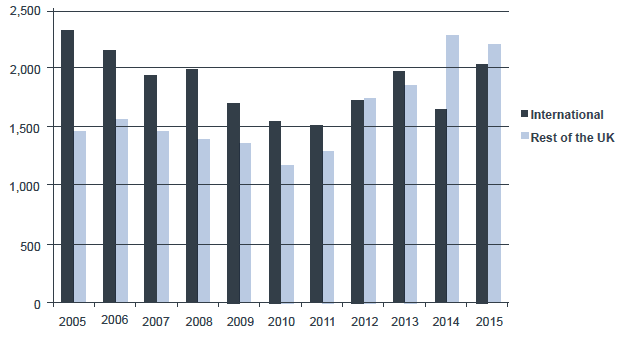 Figure 4.4.5: Scottish Exports (£ millions) for the digital sector.
Figure 4.4.5: Scottish Exports (£ millions) for the digital sector.
Source: Exports Statistics Scotland 2015.
Exports
In 2015, digital sector international exports were £2.04 billion, 7% of Scotland's total international exports. The digital sector's exports to the rest of the UK were £2.2 billion, making up 4.4% of aggregate Scottish exports to the rest of the UK. [98]
Figure 4.4.5 demonstrates that although digital sector exports to the rest of the UK have declined slightly between 2014-15, international exports have increased by approximately 23% over the same period.
Digital Clusters and Specialisation Within Scotland [99]
Digital technology clusters are geographical concentrations of digital businesses that specialise in particular areas of digital technologies. Scotland is the home to three main digital clusters: Edinburgh, Glasgow and Dundee. The information below has been extracted from the 2016 Tech Nation Report.
Edinburgh
Edinburgh is Scotland's leading digital cluster, with key strengths in financial technology (fintech), cyber security, digital marketing and advertising and cloud computing. Edinburgh is also the birthplace of billion dollar companies such as Skyscanner and Fanduel.
- Digital businesses make up 18% of all businesses in Edinburgh. [100]
- GVA grew by 58% between 2010-14. [101]
- Digital employment has increased by 23% between 2011-14. [102]
- Turnover increased by 48% between 2010-14. [103]
- The majority of digital businesses cited access to local networks and commercial property as key benefits for locating in Edinburgh. [104]
- 47% of digital businesses reported that limited talent supply would be a future challenge.
Glasgow
Glasgow is an incubator for digital start-ups, with specialities in social networks, e-commerce and fintech.
- Digital businesses make up 18% of all businesses in Glasgow.
- GVA grew by 45% between 2010-14.
- Turnover increased by 42% between 2010-14.
- Digital jobs increased by 13%between 2011-14.
- The key benefit from locating in Glasgow were cited as access to commercial property.
- Limited access to finance and weak digital infrastructure were reported to present challenges by 55% and 48%of businesses, respectively.
Dundee
Dundee is best known for its prominent gaming industry and is home to the internationally recognised Grand Theft Auto. Dundee also has strengths in app and software development, as well as online gambling.
- Digital businesses make up 16% of all businesses in Dundee.
- GVA grew by 42% between 2010-14.
- Turnover increased by 129% between 2010-14.
- Productivity, measured by sales per worker, increased by 67% between 2010-14.
4.5 Public Service Reform
The use of online public services in Scotland has increased over time. The percentage of internet users reporting having used government websites increased from 50% in 2007 to 64% in 2014. [105] The most common reason for accessing public services online is to look up information and fill out forms. Furthermore, the majority of users agreed that online public services are easy to use and helped them save time and money.
The transition to increased delivery of public services online may enhance accessibility of services to rural and isolated communities and those with mobility difficulties. However, as only 59% of Scottish households with an income of £15,000 per year or less have home internet access marginalised groups may become more excluded from public services. [106]
Resilient digital technologies can enable the provision of cost-effective public services that are designed around the needs of users. Data and other forms of performance information also allow for continuous improvement of services.
Cost Savings
Increasing collaborative ICT procurement has resulted in substantial monetary savings across our public bodies. The figures opposite demonstrate our year-on-year savings: [107]
Figure 4.5.1: Cost savings achieved through collaborative ICT procurement.
| Year | 2015/16 | 2014/15 | 2013/14 | 2012/13 | 2011/12 |
|---|---|---|---|---|---|
| Savings | c. £54.4 million | c. £48.7 million | c. £46.3 million | c. £32.7 million | c. £23.4 million |
User Satisfaction
Figure 4.5.2 shows the percentage of online public service users that were satisfied with various aspects of public service delivery. 86% of users were satisfied with the overall quality of online public services.
Figure 4.5.2: Perception of using public service websites, 2015.
| Accessing public services online helps me save time | 89 |
|---|---|
| Accessing public services online helps me save money | 54 |
| It is easier to access public services online than in person | 78 |
| I am satisfied with the ease of finding information on public services websites | 81 |
| Public services websites are easy to use | 77 |
| I am satisfied with the overall quality of the public services I have used online | 86 |
| Base (minimum) | 1,440 |
Source: Scottish Household Survey 2015.
In addition, satisfaction amongst mygov users is high. Over a five month period from September 2015 to February 2016, approximately 73% of users were satisfied with the usefulness of the content. [108]
4.6 Cyber Resilience
The increasing use of technology at home and at work means an increased risk of information, operations and finances being stolen, compromised or disrupted. Developing cyber awareness and resilience across Scotland is a key priority.
Figure 4.6 illustrates the security measures that people take to protect themselves when online. It is clear that some measures are used more widely than others, with two-thirds of adults indicating that they avoid opening emails or attachments from unknown people, whilst just under a third said they make sure their mobile phone has up-to-date antivirus software.
Use of the various online security measures varies by age, with those aged 60 and above generally less likely to adopt each of the measures than those in younger age groups. In addition, adults living in the 20% most deprived areas of Scotland were generally less likely than those in the rest of Scotland to adopt each of the security measures and more likely to say that they took none of the suggested actions.
Figure 4.6: Online security measures by age and deprivation, 2015.
| Adults | 16-24 | 25-34 | 35-44 | 45-59 | 60-74 | 75 plus | 20% Most deprived | Rest of Scotland |
Scotland |
|---|---|---|---|---|---|---|---|---|---|
| Download and install software updates/patches when promoted | 60 | 65 | 64 | 61 | 54 | 31 | 49 | 62 | 60 |
| Avoid openkng emails or attachments from unknown people | 64 | 71 | 68 | 68 | 63 | 44 | 55 | 69 | 66 |
| Use different passwords for different accounts | 63 | 68 | 62 | 62 | 55 | 34 | 50 | 64 | 61 |
| Set complex passwords | 64 | 56 | 55 | 47 | 40 | 22 | 41 | 53 | 51 |
| Change passwords for online accounts regularly | 37 | 36 | 31 | 32 | 24 | 7 | 29 | 32 | 31 |
| Avoid giving personal information online | 67 | 67 | 65 | 65 | 62 | 50 | 54 | 67 | 65 |
| Make sure my computer has up-to-date anti-virus software | 42 | 40 | 36 | 28 | 20 | 6 | 32 | 32 | 32 |
| Make sure my home wi-fi is protected with a username and password | 58 | 61 | 64 | 58 | 55 | 28 | 45 | 61 | 58 |
| Back-up important information | 53 | 42 | 39 | 38 | 33 | 16 | 30 | 42 | 40 |
| None of these | 6 | 3 | 6 | 11 | 12 | 21 | 13 | 8 | 8 |
| Base (minimum) | 230 | 340 | 420 | 670 | 510 | 110 | 380 | 1,900 | 2,280 |
Source: Scottish Household Survey 2015.
Contact
Email: Deborah McGovern
There is a problem
Thanks for your feedback